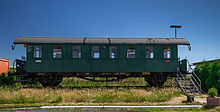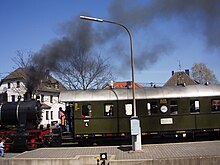Blunderbuss (passenger car)
| Two-axle standard through car | |
|---|---|
| Number: | 8255 passenger cars and 917 baggage cars |
| Year of construction (s): | 1921 to 1931 |
| Length over buffers: | 13,920 mm (Bi-29: 14,040 mm) |
| Fixed wheelbase: | 8,500 mm |
| Empty mass: | Timber construction: 18.0 t Iron construction: 17.6–20.0 t All- steel construction: 19.5–21.4 t Baggage trolley: 18.4–20.5 t |
| Top speed: | 90 km / h |
The name Donnerbüchse (originally Donnerwagen ) refers to the two-axle through passenger cars of the Deutsche Reichsbahn , which were built from 1921 and, in contrast to the previous versions, were made entirely of iron or steel (all-steel construction). The name is based on the strong roar of these vehicles due to the lack of insulation. The direct predecessors of these wagons also received this designation despite their wooden design.
History of origin
Since the Deutsche Reichsbahn suffered from a severe shortage of wagons due to the armistice taxes at the beginning of the 1920s, new passenger wagons of standard design were procured from 1921 . Although the iron design was already required here, most of the wagon factories could not change their production immediately, so that the vast majority of the wagons from the first deliveries were still made with wooden car bodies. Between 1921 and 1923, 90 iron and 2,639 wooden wagons were put into service. While the wooden wagons were built exclusively as 4th class wagons, the iron wagons were delivered as second / third / fourth and even second and fourth class wagons.
In several procurement programs , a further 517 fourth-class all-steel wagons followed in 1927/28 (440 in interchangeable design ) and from 1928 to 1930 a total of 5009 second, third and third / fourth class wagons (of which 3377 in interchangeable design), so that by 1930 more than 8,250 Had gone into operation. The initially predominantly built fourth class cars were initially redesigned as 3rd class cars when they were abolished in 1928 and later converted.
Apart from Behelfspersonenwagen (MCi) and railcar - sidecar were the Donnerbüchsen the last newly purchased two-axle coaches and the last standard-gauge cars with open end platforms in Germany.
In addition to the cars created 1923-1931 and 917 vans Pwi in a similar design.
Types
Timber construction
|
Genus until 1928 |
Genus from 1928 |
Seats | number | Year of construction (s) | Remarks |
|---|---|---|---|---|---|
| Di-21c | Cid-21c | 66 | 6th | 1921 | Trial series |
| Tue-21 | Cid-21 | 66 | 2236 | 1921-23 | |
| Tue-21a | Cid-21a | 66 | 397 | 1921-23 |
Iron construction
|
Genus until 1928 |
Genus from 1928 |
Seats | number | Year of construction (s) | Remarks |
|---|---|---|---|---|---|
| Bi-21 | Bi-21 | 40 | 10 | 1921-23 | Test car |
| BCi-21 | BCi-21 | 16/34 | 10 | 1921-23 | Test car |
| BDi-21 | BCid-21 | 16/39 | 10 | 1923 | Test car |
| Ci-21 | Ci-21 | 58 | 10 | 1923 | Test car |
| Di-21b | Cid-21b | 66 | 50 | 1922 | Test car |
All-steel construction - "Donnerbüchsen"
|
Genus until 1928 |
Genus from 1928 |
Seats | number | Year of construction (s) | Remarks |
|---|---|---|---|---|---|
| Tue-26 | Cid-26 | 66 | 77 | 1927-28 | |
| Tue-27 | Cid-27; Ciu-27/28 | 66 | 440 | 1927-28 | Replacement construction |
| BCi-28 | BCi-28 | 15/34 | 449 | 1928-29 | Replacement construction |
| Ci-28 | Ci-28 | 58 | 1744 | 1928-29 | Replacement construction |
| CDi-28 | CCid-28; CCiu-28 | 29/29 | 40 | 1928 | Replacement construction |
| Bi-29 | Bi-29 | 38 | 1632 | 1929-30 | |
| BCi-29 | BCi-29 | 15/34 | 500 | 1929-30 | Replacement construction |
| Ci-29 | Ci-29 | 58 | 450 | 1929-30 | Replacement construction |
| Ci-30 | Ci-30 | 58 | 194 | 1929-30 | Replacement construction |
Van
|
Genus until 1928 |
Genus from 1928 |
Loading weight | number | Year of construction (s) | Remarks |
|---|---|---|---|---|---|
| Pwi-23 | Pwi-23 | 7.0 t | 287 | 1923-27 | |
| Pwi-27 | Pwi-27 | 7.0 t | 40 | 1927-28 | |
| Pwi-28 | Pwi-28 | 7.0 t | 40 | 1928 | Replacement construction |
| Pwi-29 | Pwi-29 | 7.0 t | 370 | 1929-30 | Replacement construction |
| Pwi-30 | Pwi-30 | 7.0 t | 150 | 1930 | Replacement construction |
| Pwi-31 | Pwi-31 | 7.0 t | 30th | 1931 | Replacement construction |
Modifications and use
From 1930 onwards, some of the Di-21 type wagons were converted into cargo wagons.
In 1930 and 1934, 25 type Cid-21 cars were fitted with simple mail compartments ; they then ran under the names CPostid-22/30 and CPostid-21/34.
At the DB , the original wooden benches for passengers have been replaced by upholstered benches . With the abolition of the international old first class on June 3, 1956 (transition from the three to the two class system), the B and C cars were redesignated as A and B cars.
In 1951, some Ci cars were converted into control cars (CPwif) for push- pull trains hauled by steam locomotives . For this purpose, a driver's cab was installed at one end , they were given a red color scheme and an additional luggage compartment.
The decommissioning of the Donnerbüchsen began in the early 1960s, but many of them were still converted into construction wagons and used as such. The Federal Railroad used the last cars in passenger transport until the end of the 1970s . These cars are still in use today on many museum railways .
In Poland these cars were used in passenger train services until 1989.
literature
- Joachim Deppmeyer: The standard passenger and baggage car of the Deutsche Reichs Bahn. Types 1921–1931 - standard gauge. Franckh, Stuttgart 1982, ISBN 3-440-05111-0 .



